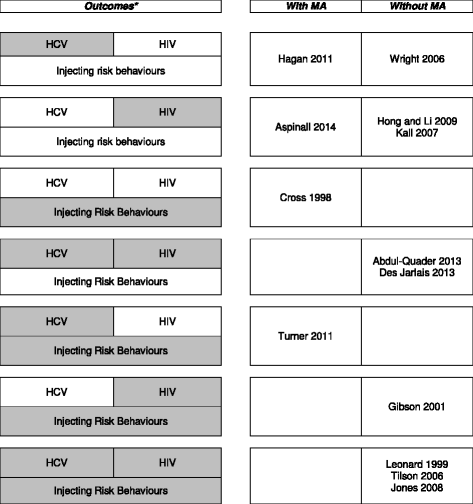Effectiveness of needle and syringe Programmes in people who inject drugs - An overview of systematic reviews
- PMID: 28399843
- PMCID: PMC5387338
- DOI: 10.1186/s12889-017-4210-2
Effectiveness of needle and syringe Programmes in people who inject drugs - An overview of systematic reviews
Abstract
Background: Needle and syringe programmes (NSP) are a critical component of harm reduction interventions among people who inject drugs (PWID). Our primary objective was to summarize the evidence on the effectiveness of NSP for PWID in reducing blood-borne infection transmission and injecting risk behaviours (IRB).
Methods: We conducted an overview of systematic reviews that included PWID (excluding prisons and consumption rooms), addressed community-based NSP, and provided estimates of the effect regarding incidence/prevalence of Human Immunodeficiency Virus (HIV), Hepatitis C virus (HCV), Hepatitis B virus (HBV) and bacteremia/sepsis, and/or measures of IRB. Systematic literature searches were undertaken on relevant databases, including EMBASE, MEDLINE, and PsychINFO (up to May 2015). For each review we identified relevant studies and extracted data on methods, and findings, including risk of bias and quality of evidence assessed by review authors. We evaluated the risk of bias of each systematic review using the ROBIS tool. We categorized reviews by reported outcomes and use of meta-analysis; no additional statistical analysis was performed.
Results: We included thirteen systematic reviews with 133 relevant unique studies published between 1989 and 2012. Reported outcomes related to HIV (n = 9), HCV (n = 8) and IRB (n = 6). Methods used varied at all levels of design and conduct, with four reviews performing meta-analysis. Only two reviews were considered to have low risk of bias using the ROBIS tool, and most included studies were evaluated as having low methodological quality by review authors. We found that NSP was effective in reducing HIV transmission and IRB among PWID, while there were mixed results regarding a reduction of HCV infection. Full harm reduction interventions provided at structural level and in multi-component programmes, as well as high level of coverage, were more beneficial.
Conclusions: The heterogeneity and the overall low quality of evidence highlights the need for future community-level studies of adequate design to support these results.
Trial registration: The protocol of this systematic review was registered in Prospective Register of Systematic Reviews (PROSPERO 2015: CRD42015026145 ).
Keywords: HIV/Aids-Hcv-Hbv; Harm reduction interventions; Needle and syringe programmes; People who inject drugs.
Figures


References
-
- UNAIDS . UNAIDS: the gap report. 2014.
-
- WHO . Guidance on prevention of viral hepatitis B and c among people who inject drugs. Geneva: WHO; 2007. - PubMed
-
- Torre C. Syringe exchange Programmes in the context of harm reduction. Arq Med. 2009;23:119–131.
Publication types
MeSH terms
LinkOut - more resources
Full Text Sources
Other Literature Sources
Medical

